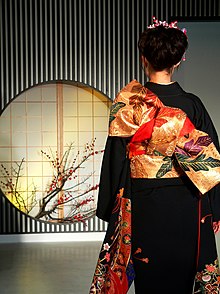Our website is made possible by displaying online advertisements to our visitors.
Please consider supporting us by disabling your ad blocker.
Obi (sash)

An obi (帯) is a belt of varying size and shape worn with both traditional Japanese clothing and uniforms for Japanese martial arts styles. Originating as a simple thin belt in Heian period Japan, the obi developed over time into a belt with a number of different varieties, with a number of different sizes and proportions, lengths, and methods of tying. The obi, which once did not differ significantly in appearance between men and women, also developed into a greater variety of styles for women than for men.
Despite the kimono having been at one point and continuing to appear to be held shut by the obi, many modern obi are too wide and stiff to function in this way, with a series of ties known as koshihimo, worn underneath the obi, used to keep the kimono closed instead.
Obi are categorised by their design, formality, material, and use, and can be made of a number of types of fabric, with heavy brocade weaves worn for formal occasions, and some lightweight silk obi worn for informal occasions. Obi are also made from materials other than silk, such as cotton, hemp and polyester, though silk obi are considered a necessity for formal occasions. In the modern day, pre-tied obi, known as tsuke or tsukiri obi, are also worn, and do not appear any different to a regular obi when worn.
Though obi can be inexpensive when bought second-hand, they typically cost more than a kimono, particularly when purchased brand-new. A number of specialist fabrics used particularly to make obi are highly prized for their craftsmanship and reputation of quality, such as nishijin-ori, produced in the Nishijin district of Kyoto, and hakata-ori produced in Fukuoka prefecture.
Previous Page Next Page


